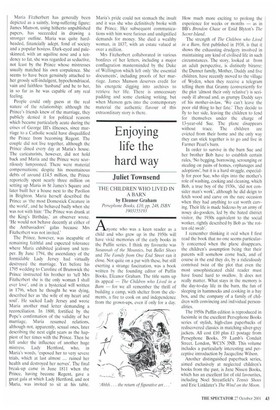Enjoying life the hard way
Juliet Townsend
THE CHILDREN WHO LIVED IN A BARN by Eleanor Graham Persephone Books, £10, pp. 248, ISBN 1903155193 Aiyone who was a keen reader as a child and who grew up in the 1950s will have vivid memories of the early books in the Puffin series. I think my favourite was Susannah of the Mounties, but Ballet Shoes and The Family from One End Street ran it close. Not quite on a par with these, but still exerting a strange fascination, was a book written by the founding editor of Puffin Books, Eleanor Graham. The title sums up its appeal — The Children who Lived in a Barn — for we all remember the thrill of building a camp, with shelter from the elements, a fire to cook on and independence from the grown-ups, even if only for a day.
How much more exciting to prolong the experience for weeks or months — as in BB's Brendan Chase or Enid Blyton's The Secret Island.
The strength of The Children who Lived in a Barn, first published in 1938, is that it shows the exhausting drudgery involved in maintaining any kind of civilised life in such circumstances. The story, looked at from an adult perspective, is distinctly bizarre; the Dunnet family, Mother, Daddy and five children, have recently moved to the village of Wyden, when they receive a telegram telling them that Granny (conveniently for the plot 'almost their only relative') is seriously ill abroad and, as grumpy Daddy says of his mother-in-law, 'We can't leave the poor old thing to her fate.' They decide to fly to her side, leaving the children to fend for themselves under the charge of 13-year-old Sue. The plane disappears without trace. The children are evicted from their home and the only way they can stick together is to go and live in Farmer Pearl's barn.
In order to survive in the barn Sue and her brother Bob have to establish certain rules, 'No begging, borrowing, scrounging or stealing on pains of homes, orphanages and adoptions', but it is a hard struggle, especially for poor Sue, who slips into the mother's role of washing, cooking and cleaning, which Bob, a true boy of the 1930s, 'did not consider man's work', although he did deign to fetch wood and carve on the rare occasion when they had anything to eat worth carving. Their life is made hideous by an army of nosey do-gooders, led by the hated district visitor, the 1930s equivalent to the social worker, rightly described by Bob as the rotten old swab'.
I remember thinking it odd when I first read the book that no one seems particularly concerned when the plane disappears, the children's assumption being that their parents will somehow come back, and of course in the end they do, by a ridiculously contrived twist of the plot that even the most unsophisticated child reader must have found hard to swallow. It does not really matter. What stays in the memory is the day-to-day life in the barn, the fun of sleeping in hammocks and cooking in a hay box, and the company of a family of children with convincing and individual personalities.
The 1950s Puffin edition is reproduced in facsimile in the excellent Persephone Books series of stylish, high-class paperbacks of rediscovered classics in matching silver-grey jackets. All cost £10 plus £1 postage from Persephone Books, 59 Lamb's Conduit Street, London, WC1N 3NB. This volume includes a particularly interesting and perceptive introduction by Jacqueline Wilson.
Another distinguished paperback series, aimed exclusively at neglected children's books from the past, is Jane Nissen Books, which has an excellent list of old favourites, including Noel Streatfield's Tennis Shoes and Eric Linklater's The Wind on the Moon.










































































 Previous page
Previous page